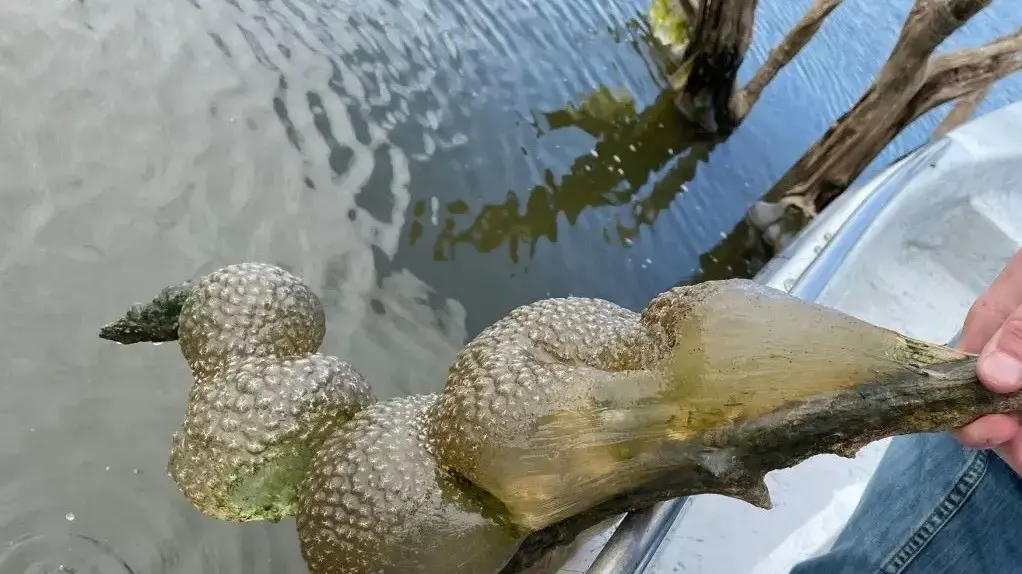This is what the plesiosauria looked like/@cokemovie1
Imagine going in for a swim in the lake and encountering this terrifying thing. How would you react? Shocked Oklahomans have vowed never to go near McGee Lake again after being exposed to photos taken there, showing what have been dubbed "Godzilla eggs" or "Eighth Passenger eggs."
The Oklahoma Department of Wildlife Conservation shared photos on its Facebook page of the creepy-crawly-textured balls hanging from the branches of a sunken tree. "If you go boating in an area like McGee Reservoir, you may notice the strange jelly-like balls hanging from submerged tree limbs," the Conservation Department presenters wrote in a March 12 post that went viral. In the accompanying photos you can see greenish balls with a shell that is partly hard and partly jelly, dangling from a tree that is underwater - just like Christmas ornaments.
Speculations began to run online about the origin of the balls, with the least frightening theory claiming that they were the eggs of a giant toad of an unknown species. Others went further and suggested Godzilla or that it was alien eggs threatening to take over Earth. "What on earth and aliens is this thing?!" asked a shocked viewer in the comments to the post, "All I can think about is if I touched it or it touched me while I was in the water, I would freak out," added another disturbed viewer.
A colony of the strange slime balls has been spotted in a lake in Oklahoma/screenshot, Oklahoma Department of Wildlife Conservation
So dear Oklahomans, you can relax. Not only are these eggs harmless, they even contribute to the ecosystem. These strange balls are actually colonies of aquatic microorganisms known as bryozoans. They form colonies by building coral-like exoskeletons and attach themselves to submerged rocks or branches in water sources. Their backbone consists of a substance called chitin that hardens when dry to protect the organism from dehydration.
More underwater discoveries
Over 5,000 new species of aquatic creatures have been discovered in the depths of the ocean - And they are already in danger of extinction
. An ancient mystery: Did fishermen remove a dinosaur from the water and throw it back?
with an exclusive discount
Hair falling out? The American miracle device will put an end to it quickly
In collaboration with HairMax
Although they seem like creatures best kept at a distance, bryozoans have an important role/screenshot, Oklahoma Department of Wildlife Conservation
In the book "The Flora and Fauna of the Land of Israel: A Useful Illustrated Encyclopedia" it is explained that Hathabs are a set of colonized, permanent invertebrates. Most of them live in rivers and a minority in streams and freshwater mikva. These animals have a complex internal structure: most of them have a skeleton coated with a thin cuticle layer (a fatty layer, impermeable to water and gases). The representatives of the group live in all the seas and oceans in many and varied nests, about 4,000 known living species of bats today and the number of fossil species is much greater. Their beginnings are very ancient and their remains remain in many geological layers. These animals have no clear systematic kinship to another system of invertebrates. Some of the hithab colonies are membranous and cover the substrate and some resemble tiny bushes and sometimes large colonies are formed that resemble corals. Each individual in the colony looks like a tiny box and in membranous colonies the individuals are close to each other on their side walls and their opening is directed upwards.
The opening of the owners of the calcareous skeleton is closed by a rounded chitinous lid and through the opening a bunch of delicate, flexible and ciliated arms are pulled out, which surround the mouth located in the center. The arms form a kind of funnel around the mouth and food particles are carried to it by the current of water created by the movement of the eyelashes. The internal organs within the skeletal box include a mechanism for retracting the armature, a simple horseshoe-shaped intestine, a reproductive system, and a nervous system. Hathabs do not have sense organs or excretory organs.
The Oklahoma Department of Wildlife Conservation wrote: "They are not a danger to you or the wildlife. In fact, they are an indicator of maintaining the quality of the environment and clear water. These microorganisms are an important part of the ecosystem as they help clean the water and serve as prey for mussels, snails and even small fish". have you calmed down
More on the same topic:
aliens

